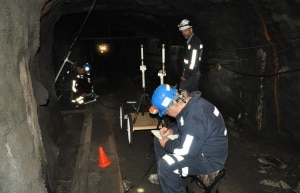Mining Topic: Emergency Communications and Tracking
What is the health and safety problem?
In the event of an underground emergency, mine workers should have a way to communicate with and be tracked by people on the surface. The Mine Improvement and New Emergency Response Act (MINER Act) of 2006 requires mines to have wireless communications and electronic tracking systems in underground coal mines. The intent is to provide communications and location information between surface personnel and underground workers. The systems should be survivable and remain operational following a disaster to aid in self-escape and rescue operations.
What is the extent of the problem?
As a result of the MINER Act, all underground coal mines now have some form of wireless communications and tracking (CT) systems installed. However, because every radio has a limited transmission range, all CT technologies require some amount of underground infrastructure to transfer messages and information between the working section and the surface. The infrastructure could be damaged by a disaster, rendering the CT systems inoperable. Therefore, mine operators, regulators, and CT manufacturers need a way to assess the survivability of CT systems quickly and effectively. Further, this assessment needs to account for the specific mine layout, the type of CT equipment, the installation configuration, and the disaster definition (location, type, extent, forces, temperatures, and debris).
How is the NIOSH Mining program addressing this problem?

NIOSH researchers measure radio signal propagation in a coal mine.
The NIOSH Mining Program has funded and continues to fund the development of advanced and potentially more survivable CT systems. NIOSH Mining has assembled an experienced intramural CT research team supported by nationally recognized laboratories, universities, and subject matter experts. The initial research is focusing on developing computer models to predict radio signal attenuation and its dependency on geometric and electrical properties of the mine. The model predictions are then validated by radio frequency (RF) measurements performed in mines.
What are the significant findings?
Radio signal propagation underground is very different from propagation on the surface. The mine environment plays a major role in limiting the number of methods by which radio signals can propagate. At conventional cell phone frequencies, propagation is through the air; however, in mines, the tunnels themselves can act as an RF guide for the signals. At lower frequencies, RF signals couple onto conductors within the mine entries, such as water pipes, power lines, trailing cables, pager phone wires, etc. At the lowest frequencies, it is possible to propagate RF signals directly through the earth. NIOSH is investigating each of these three propagation mechanisms, categorized as ultra-high frequency (UHF), medium frequency (MF), and through-the-earth (TTE) respectively.
NIOSH has completed the assessment and evaluation of the RF measuring equipment needed for each of the three RF frequency bands. Initial measurements have been made at several mine sites and results have been compared with model predictions. Each frequency band requires a significantly different model.
Radio communications research has some application for electronic tracking systems, but there are some significant differences as well, so tracking involves a separate research effort. More background on the various types of CT systems can be found in the Tutorial on Wireless Communications and Electronic Tracking, Part 1 and Part 2.
What are the next steps?
NIOSH will complete the RF propagation model development and validation in each of the three frequency bands. The propagation models will serve as inputs to a larger model that will quantitatively evaluate the survivability of the CT system and be able to perform “what if” evaluations of alternative CT technologies, installation configurations, and several disaster scenarios in a specific mine. Tracking research will identify systems with reduced infrastructure requirements, which will likely increase the system’s survivability.
- Advanced Tutorial on Wireless Communication and Electronic Tracking: Introduction
- Basic Tutorial on Wireless Communication and Electronic Tracking: Technology Overview
- Mine Communications Engineering and Compatibility Guidelines
- Passive Fiber Optic System for Locating, Tracking, and Communicating with Personnel in Coal Mines
- Refuge Alternatives in Underground Coal Mines
- Refuge Chamber Deployment and Occupancy Status During Mine Emergency Situations
- Sprinkler Head Emergency Communications
- System Reliability and Environmental Survivability
- Technology News 543 - Reverse Implementation of Radio Frequency Identification (RFID) Technology for Personnel Tracking in Underground Mines
- Technology News 544 - New Measurement Tool to Validate Wireless Communications and Tracking Radio Signal Coverage in Mines
- Technology News 546 - Medium Frequency Mine Emergency Communications - An Emerging Technology
- Theory on the Propagation of UHF Radio Waves in Coal Mine Tunnels
- Through-The-Earth Wireless Real-Time Two-Way Voice Communications
- Wireless Mesh Mine Communication System